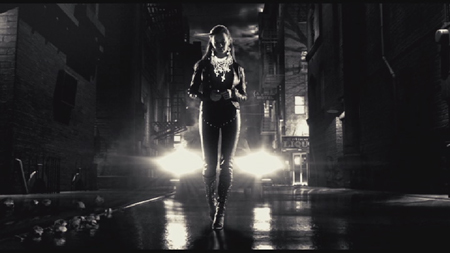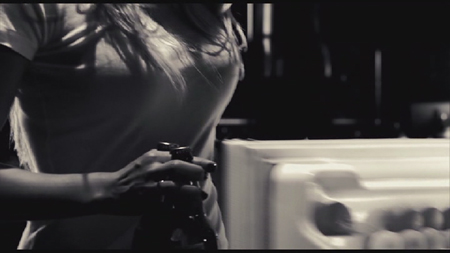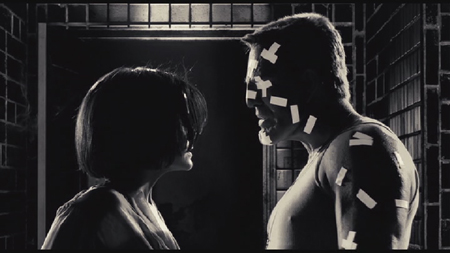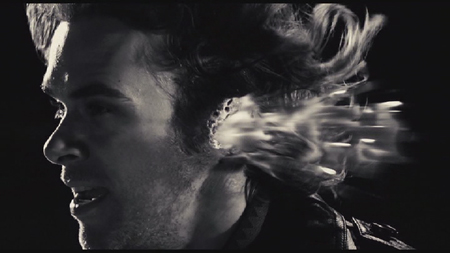 BUY IT AT AMAZON: CLICK HERE!
BUY IT AT AMAZON: CLICK HERE!
STUDIO: Dimension
MSRP: $39.99
RATED: Theatrical Cut: R; Everything Else: Unrated
RUNNING TIME: Theatrical Cut: 124 Minutes; Extended Cuts: 147 Minutes Total
SPECIAL FEATURES:
• Commentaries by Robert Rodriguez, Frank Miller, Quentin Tarantino
• Audio track of Austin premier audience
• "15 Minute Flic School"
• "10 Minute Cooking School"
• "The Long Take" of Tarantino’s guest segment
• Cast and crew party
• Cars of Sin City featurette
• Costuming featurette
• Special-effects makeup featurette
• Props featurette
• "How It Went Down: Convincing Frank Miller to Make Sin City"
• Casting featurette
• Profile of Quentin Tarantino’s guest-direction
• "Sin-Chroni-City" interactive game
• Full "The Hard Goodbye" graphic novel
• Bloopers
• Trailers
One of
the things that draws an audience to fiction is the exaggeration. Even in
stories that pride themselves on their realism, there is an exaggeration of
personality, built around the goals of the characters. Subtle characters still
possess a focus that real humans, with our decompressed stories, tend to lack.
about exaggeration, which only brushes up against reality to steal its wallet.
Frank Miller’s original graphic novels are full of characters broad enough to
occupy an entire page, and action so stylized as to reach that pinnacle of cool violence. We got one bare bones DVD
release of Robert Rodriguez’ and Miller’s project earlier this year, but alongside
the new footage, this set also includes the original theatrical cut, rendering
that first release utterly moot. The question for buyers to ask, then, is
whether or not the extended footage and bonuses are worth the studio’s double
dip.
The Flick
three and one piece of flash fiction) that initially appeared as
separately-published comics. Frank Miller’s comics are drawn in heavy ink and
bold negative space, all blacks and whites, with the occasional dab of garish
color, and not a shade of gray in sight. Rodriguez goal of translating the
comic panels directly to film was a bold decision, an approach almost archaic
in the way it mirrored the first film adaptations of stage plays. Not much in
the way of additions or alterations were made to the comics; instead, they were
used as story-boards, and together Rodriguez and Miller were able to paint
their cinema frames with many of the same contrasts as were inked on the page.

"Keep the sheep in the pen. In the pen. No, wait… out of the pen? Damn."
Each of
the four tales takes a different angle on the subject of vengeance. The lead
story, "The Hard Goodbye," was Miller’s first
introduction to the world. In the first few minutes, the audience is exposed to
over-the-top violence and unrealistic physics, and, once the disbelief is
suspended, and the physical exaggerations are accepted, the story just barrels
on from there. Mickey Rourke, under a brilliant set of prosthetics, plays Marv,
a ugly son-of-a-bitch who spends one night with an angelic hooker only to wake
up and find her dead. He dedicates the rest of his worthless life to tracking
down and punishing whoever killed her. Marv’s vengeance is hot, confused, and
instinctive.
"The
Big Fat Kill" is Dwight’s story, played by Clive Owen, who finds himself
caught up in helping a few ladies of negotiable affection protect themselves
against the businesslike vengeance of the local cops. Because there has never
been a touch of altruism in
vendetta of its own, and Dwight’s satisfaction comes not from a job well-done,
but from dirtbags well-executed.
The third
main story features Bruce Willis as Detective Hartigan in "The Yellow
Bastard." Hartigan is one of the few cops not bent double-crooked in the
city, and his story is about the lengths he goes to in order to protect Nancy
(Jessica Alba), the one person in the world he considers innocent, from the
creepy titular pedophile/maniac, played by Nick Stahl. This is the most
emotionally resonant of the three stories, and is significantly quieter and
more focused on character. Where the other two sections are about loud,
thunderstorm violence, "The Yellow Bastard" is more of a quiet kill,
like a heavy snowfall that ices up the roads.
For a
piece that is so concerned with cinematic exaggeration,
mature for what it doesn’t include. The four considerations of vengeance
(including the bookend story, "The Customer Is Always Right," and its
melancholy hitman) are full of heavy dialogue but entirely free of moral
direction, and I’m considering that a good quality. There’s no hand holding in
stories complement each other neatly, both by context and by the occasional
direct reference.

"Split my goddamn arrow, will you? Not with Maid Marion watching, you bastard."
Populating
the moral-free zone is a veritable pantheon of minor gods. In addition to those
already named, the film also features Elijah Wood, Benicio del Toro, Michael
Madsen, Alexis Bledel, Michael Clarke Duncan, Josh Hartnett, Rutger Hauer,
Rosario Dawson, Brittany Murphy, Carla Gugino, and, shit, probably a partridge
somewhere. Most hit the nail on the head in their roles, managing the
conviction and broadness required by their exaggerated characters while
avoiding the trap of overacting. A few lines fall flat, thanks to bad delivery:
Jamie King botches a couple of good ones, and Michael Madsen is more wooden
than his character ought to be. Overall, though, the cast seems really to get
into their roles, and the performances range from serviceable to downright
delicious.
The fact
that the movie is a labor of love I suspect contributes a lot to its success.
The falling out that Rodriguez had with the DGA over his decision to bring
Miller on as co-director is well-documented. What it means for this release is
that the viewer gets a nice truckload of informative bonuses, as well as a chance
to see what the duo’s unedited vision is like. Suffice it to say that their
unedited vision is a lot like what ended up in the theatrical cut. The
recutting expands each of the three primary stories into what are essentially
shot-for-shot recreations of the comics. In total, there are about twenty
minutes of new footage edited back into the stories, but none of it is
essential. The edit stands, primarily, as a tribute to Rodriguez’ desire to be
faithful to Miller’s vision, and Miller’s contribution to the creation of a
faithful film.
As nice
as it is to have the four stories extended and placed separately on the DVD for
easier consumption, the isolation makes for a less cohesive film. The new
versions are definitely fan service, as they don’t function quite as well as
stand-alone stories as they do when caught up in the context of the feature
film. This is especially true for "The Customer Is Always Right,"
which is too short to stand alone. The strength of the film is in the sum of
its parts, and, though the parts are individually exciting and entertaining, the
sum is necessarily greater, or so my calculator tells me.
evolution of popular comic book movies, and, as an experiment, an unqualified
success. That’s not to suggest that more movies should use their source
material as storyboards, but rather that move comic flicks ought to so deeply
inhabit and enjoy their origins.
8.7 out of 10

Lost time is lost money, honey.
The Look
1.85:1
widescreen. Shadows are almost more prevalent in
blackness is transferred beautifully. This is a remarkably clear version of the
film. The combination of the varied characters, with their great costumes, and
the highly detailed backgrounds gives your eye plenty of room to wander. It
will rarely be disappointed.
Rodriguez
wanted to incorporate more color into the film than had appeared in the
original comics, and it works well. He adds a red tint to blood in places where
it would otherwise just look like grime on a character’s face, and adds little
beats of other color that suggest, in their brief appearances, a bit more
humanity (or, in a couple cases, inhumanity).
The
transfer here is no different than that of the previous DVD release, but it is
of good quality.
8.5 out of 10

"Not… uh, not usually the effect I have on women."
The Noise
Hurrah
for the advent of our DTS overlords! You get two tracks: the DTS 5.1 and the
Dolby digital 5.1, and just guess which one kicks more ass. This is a film just
packed with typically exaggerated sound effects: screeching tires, hand-cannon
discharges, meaty flesh wounds, sirens, and car crashes, just to name a few.
The DTS track puts them all right into your chest and head. The Dolby track is a
good second choice, but lacks the presence of its big brother.
One
quibble is that the instrumental bits of the score, another thing that
Rodriguez handles in his DIY fashion, are somewhat bland, and they don’t get
the quality treatment that the rest of the sound design received. This isn’t a
film that fails on the basis of its score, since all the heart is right out on
its sleeve already, but it is an element that fails to impress on the same
level as everything else.
8.3 out of 10

Wow. Thanks. Just… thanks.
The Goodies
This is
what we’ve been waiting for since the bare-bones release earlier this year.
Disc one, which contains the unaltered theatrical cut of the film, features
three alternate audio tracks: one with commentary by Rodriguez and Miller, one
with commentary by Rodriguez and Tarantino, and one that presents the audience
reactions to film at its
The first
commentary, with the two co-directors, is a mutual admiration society.
Rodriguez has an inexhaustible wealth of enthusiasm for the film, for Miller,
and for the processes of filmmaking in general. Miller is a little more
subdued, a little more focused on
play well off each other and give an insight into what will hopefully be a
successful, sustained working partnership.
The
second commentary, with Quentin Tarantino joining Rodriguez, finds both mavericks
at their most energetic. Tarantino has a lot of love for the whole film (not
just his contribution as guest director) and his friendship with Rodriguez
coaxes out a whole different side of the latter’s enthusiasm. While it doesn’t
offer as many insights in
to.
The last
alternate audio is something new to this reviewer. Generally, I can’t stand it
when an audience is vocal enough to warrant having a whole audio track devoted
to them, but the enthusiasm of the Austinites is infectious.

If Madonna looks closely enough, she can discern the name of God spelled out in bandages.
Disc
number two has the recut, extended sections of all four stories, as well as a
battalion of featurettes, ranging from the standard DVD fare to the wholly
unique.
There are
two Rodriguez staples: the "15 Minute Flic School" and the "10
Minute Cooking School". In the former, we are shown a bit of
behind-the-scenes information regarding the process of shooting with the
digital backlot process, and in the latter we are instructed on the proper way
to make a breakfast burrito. I didn’t do well on my burrito, but my cat liked
it.
We get
the uninterrupted take of Quentin Tarantino’s guest-directed segment, featuring
Dwight and the dead Jackie Boy talking in a car. The full segment runs fourteen
minutes, a small percentage of which actually ended up in the film. The whole
dialogue sequence isn’t necessary, but the feature does a nice job of showing
Tarantino’s habitual directing style.
Dovetailing
that feature is a short profile and interview segment with Quentin Tarantino,
in which he talks about his enthusiasm for and confidence in the project.
For
parties interested in the alchemy of post-production, the entire film is
included as it was shot against the greenscreen, with no props or landscapes
edited in. It’s all cut just as it appears in the theatrical cut, you just
don’t get any of the context. The whole thing is put in time-lapse, which I
thought was an odd decision, unless the DVD authors were trying to conserve
space.
There’s
an interesting featurette called "How It Went Down: Convincing Frank
Miller to Make the Film" in which Rodriguez talks about the process of
getting the comics creator to give his support to the film. What it comes down
to, for the audience, is Rodriguez’ blind faith in the project, and his willingness
to make personal sacrifices in order to get it made. These qualities also
appealed to Frank Miller, obviously, and we get to see a bit of what goes
through an artist’s mind as he considers letting go of one of his creations
(which, fortunately, Miller didn’t end up having to do).

Remember: In explosive decompression, always exhale so your lungs don’t explode.
The brain can’t be helped, I’m afraid.
There’s a
series of four short, specific featurettes: "A Hard Top with a Decent
Engine: The Cars of Sin City", "Trench Coats & Fishnets: The Costumes
of
Special Effects Make-Up", and "Booze, Broads & Guns: The Props of
and details exactly what it claims to. All four are worth watching, with at
least one nugget of fun trivia in each. The cars are interesting because of the
combination of physical and digital vehicles; the costumes are incredibly
detailed and, in the case of the girls of Old Town, complicated; the special
make-up is worth watching just to see how they managed to make Nick Stahl even more creepy; and the props are
wonderfully stylized and, again, detailed. You get three nuggets of typical
and one featurette about, well, cars.
And, if
you’re wondering why the box set is so big just for a two disc release, it’s
because they had to make room for the complete graphic novel of "The Hard
Goodbye," Marv’s story. It has been shrunk from its original size (a
couple times, now, by my count) but it’s all legible and detailed, and it’s a
lot of fun to follow along as the story plays on the screen.
Finally,
in the throwaway category, we get to go behind the scenes at the cast and crew
party, watch some bloopers, play a couple cheap Flash games, and view the
teaser and theatrical trailers.
Counting
the recut stories as bonuses, there’s really nothing more I could ask for in a
set of bonuses. They’re informative, entertaining, and wide in appeal. We even
get a few things that aren’t at all necessary.
10 out of 10
The Artwork
Note that the set I received has none of the marketing fluff on the artwork I grabbed from Amazon, but is instead just pitch
black with Frank Miller’s memorable logo. I’m always fond of properties that
have distinct and attractive fonts. The recent re-releases of the graphic
novels have abandoned the bulging, pulpy letters of Miller’s original in favor
of an uninteresting sans-serif font, but I’m glad the film did no such thing.
It’s the perfect eye-grabber: a cartoonish font, blood-red against black, that
tells a potential buyer that everything inside is larger than life, and
gloriously so.
9 out of 10
Overall: 9 out of 10